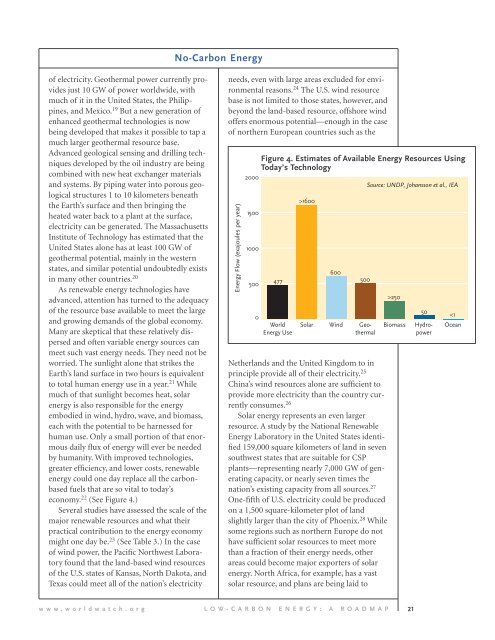Worldwatch Institute
Worldwatch Institute
Worldwatch Institute
You also want an ePaper? Increase the reach of your titles
YUMPU automatically turns print PDFs into web optimized ePapers that Google loves.
No-Carbon Energy<br />
of electricity. Geothermal power currently provides<br />
just 10 GW of power worldwide, with<br />
much of it in the United States, the Philippines,<br />
and Mexico. 19 But a new generation of<br />
enhanced geothermal technologies is now<br />
being developed that makes it possible to tap a<br />
much larger geothermal resource base.<br />
Advanced geological sensing and drilling techniques<br />
developed by the oil industry are being<br />
combined with new heat exchanger materials<br />
and systems. By piping water into porous geological<br />
structures 1 to 10 kilometers beneath<br />
the Earth’s surface and then bringing the<br />
heated water back to a plant at the surface,<br />
electricity can be generated. The Massachusetts<br />
<strong>Institute</strong> of Technology has estimated that the<br />
United States alone has at least 100 GW of<br />
geothermal potential, mainly in the western<br />
states, and similar potential undoubtedly exists<br />
in many other countries. 20<br />
As renewable energy technologies have<br />
advanced, attention has turned to the adequacy<br />
of the resource base available to meet the large<br />
and growing demands of the global economy.<br />
Many are skeptical that these relatively dispersed<br />
and often variable energy sources can<br />
meet such vast energy needs. They need not be<br />
worried. The sunlight alone that strikes the<br />
Earth’s land surface in two hours is equivalent<br />
to total human energy use in a year. 21 While<br />
much of that sunlight becomes heat, solar<br />
energy is also responsible for the energy<br />
embodied in wind, hydro, wave, and biomass,<br />
each with the potential to be harnessed for<br />
human use. Only a small portion of that enormous<br />
daily flux of energy will ever be needed<br />
by humanity. With improved technologies,<br />
greater efficiency, and lower costs, renewable<br />
energy could one day replace all the carbonbased<br />
fuels that are so vital to today’s<br />
economy. 22 (See Figure 4.)<br />
Several studies have assessed the scale of the<br />
major renewable resources and what their<br />
practical contribution to the energy economy<br />
might one day be. 23 (See Table 3.) In the case<br />
of wind power, the Pacific Northwest Laboratory<br />
found that the land-based wind resources<br />
of the U.S. states of Kansas, North Dakota, and<br />
Texas could meet all of the nation’s electricity<br />
needs, even with large areas excluded for environmental<br />
reasons. 24 The U.S. wind resource<br />
base is not limited to those states, however, and<br />
beyond the land-based resource, offshore wind<br />
offers enormous potential—enough in the case<br />
of northern European countries such as the<br />
Energy Flow (exajoules per year)<br />
2000<br />
1500<br />
1000<br />
500<br />
0<br />
Figure 4. Estimates of Available Energy Resources Using<br />
Today’s Technology<br />
477<br />
World<br />
Energy Use<br />
>1600<br />
600<br />
500<br />
Netherlands and the United Kingdom to in<br />
principle provide all of their electricity. 25<br />
China’s wind resources alone are sufficient to<br />
provide more electricity than the country currently<br />
consumes. 26<br />
Solar energy represents an even larger<br />
resource. A study by the National Renewable<br />
Energy Laboratory in the United States identified<br />
159,000 square kilometers of land in seven<br />
southwest states that are suitable for CSP<br />
plants—representing nearly 7,000 GW of generating<br />
capacity, or nearly seven times the<br />
nation’s existing capacity from all sources. 27<br />
One-fifth of U.S. electricity could be produced<br />
on a 1,500 square-kilometer plot of land<br />
slightly larger than the city of Phoenix. 28 While<br />
some regions such as northern Europe do not<br />
have sufficient solar resources to meet more<br />
than a fraction of their energy needs, other<br />
areas could become major exporters of solar<br />
energy. North Africa, for example, has a vast<br />
solar resource, and plans are being laid to<br />
Source: UNDP, Johansson et al., IEA<br />
>250<br />
Biomass<br />
50<br />
Solar Wind Geothermal<br />
Hydropower<br />









